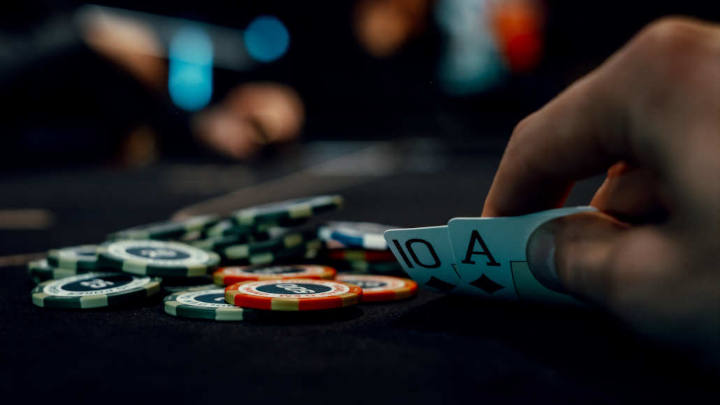How to Play Heads Up – Basic Heads up Strategy & Tips

10 minutes
The game of poker can be played in many different formats, with cash games, multi-table tournaments, and sit & goes being just a few popular ones.
Yet, it is the game of heads up poker that is widely considered by poker pros as the most skillful one and the one that rewards the best players more than any other.
If you don’t know what it is yet, heads up poker is the format of the game that’s played with just two players at the table.
You can play any poker game, such as No-Limit Hold’em or Pot-Limit Omaha, heads up. The thing that sets it apart from other game formats is that only two players are playing at any one time.
In this guide, I am going to teach you how to play heads up poker on the most basic level, what rules you need to keep in mind, and what basic strategies you should apply in the game.
If you want to maximize your edge in poker and make money by finding the weak opponents and taking them for everything they have, keep on reading!
Heads Up Poker Rules – How to Play
Although any poker game can technically be played heads up, I am going to focus on heads up Hold’em. That said, many of the rules explained here work for other games, too, especially other games with community cards like Omaha and 6+ Hold’em.
In a heads up poker game, you and your opponent will be the only two players at the table.
Thich means you are going to be posting the small and the big blind every hand.
You will, of course, take turns in posting each of the two forced bets, with the player who holds the button posting the small blind and the other player posting the big blind.
In the past, heads up Hold’em was often played with the blinds reversed, but today you will not really find many games with the reverse order.
Once a hand of heads up Hold’em is dealt, the player who has the button will be first to act, with an option to fold, complete the blind, or raise.

From here, the hand of heads up poker will go the same way as a hand of ring game, with the button being last to act on every betting street.
Apart from this, heads up poker rules are identical to other poker formats in terms of hand rankings, bet sizing, and all other elements.
If you know how to play poker, you should be able to adapt to heads up quite quickly. However, that doesn’t mean you will know how to play heads up or how to win against a more experienced poker player.
Differences Between Heads Up and Full Ring
Whether you are playing a cash game or a tournament format, there are many differences between heads up and full-ring play, or even six-max for that matter.
In games with multiple opponents, every player is dealt cards and has a hand that could end up being a winner in the end.
Depending on playing styles, players will reach flops, turns, and rivers with a variety of hand ranges, often leading to unusual situations and people making hands you would not expect.
The more players at the table there are, the less valuable poker hands will be in terms of absolute strength, as your overall equity with any hand, including pocket aces, will diminish.
Of course, raising before the flop can get rid of many of these hands, but in many poker games, people will still stick around with various garbage, often leading to multi-way pots and your equity looking much different than it does in heads up games.
In heads up poker, you are only facing one opponent, which makes equities much clearer, allows you to play more hands, and apply more strategy.
The luck factor in heads up poker is significantly diminished compared to skill, as both your opponent and you must make several decisions every single hand.
By default, the player who makes the better decisions is going to win in heads up poker. If the skill gap is significant, the win rate of the player winnings is going to be very high.
This fact is what draws many expert players to heads up, as this format allows them to dominate over the weaker players and win a lot of money very quickly.
The obstacles of ring games, where you have to contend with many players and play very slow, or tournament poker, where the variance is massive, are all gone.
Instead, you can focus on exploiting just your current opponent’s tendencies and making the best plays in every given situation to maximize your equity and win the maximum possible money in every hand.
Importance of Aggression in Heads Up Poker
Of all the heads up poker strategy tips I can give, the most important one is definitely to always stay aggressive.
Playing tight and aggressive can work to a certain degree in games with many opponents, especially if those opponents are very splashy and happy to give you their chips.

While there are, in theory, some opponents you can beat heads up by playing tight, your general approach will be to play quite loose and very aggressive.
The reasons for this are quite obvious, but I will talk about them nevertheless. The biggest reason, of course, is the dead money in the pot at the start of the hand.
There is 1.5 bb in the pot before a hand is dealt, and all you need to do to win that 1.5 bb is make one opponent fold.
Your single opponent at the table will often be dealt complete trash, which he will be forced to fold, allowing you to win the pot right then and there.
In fact, if your heads up opponent is not proficient at this game format, he will probably be folding way more hands than he should, which means you will be winning free money left and right.
Against better opponents, you will still want to play very aggressively, as this is the only way to stay afloat and not get completely overwhelmed by their aggression.
In the long run, the more aggressive opponent will often win the match, although the modern approach to heads up is somewhat more balanced but still very aggressive.
Until you start playing for very high stakes and against very competent opponents, playing very aggressively and trying to win pots whenever there is an opportunity will always be your best bet.
Playing from the Button
In heads up poker, you will play half of your hands from the button, which posts the small blind, and the other half from the big blind.
The button is by far the more favorable position, as you are forced to post less money into the pot, you will play last on every street after the flop, and you get to steal pots relentlessly before the flop.
On the button, you will want to open many hands with a raise, with some players advocating playing 100% of your hands for a raise until you face severe opposition from your opponent.
Even against a good and balanced opponent, playing about 80% of all hands from the button is usually a good idea, always coming in for a raise when you do play.

In addition to opening many hands, you will also want to defend quite a few hands against your opponents’ 3-bets and 4-bet for value or as a bluff occasionally.
To learn more about the actual hand ranges for each of these moves, I highly suggest you take a long and hard look at the heads up preflop charts, which show the optimal opening ranges, ranges for calling 3-bets, and your 4-bet ranges.
Playing from the Big Blind
The other half of your heads up hands will be played from the big blind, which is the less favorable and more difficult position to play in.
If you are playing against a competent opponent, you will be facing many raises, and you will need to defend your blind quite a bit to stay profitable in the game.
To do this, you will have to call with many hands and include a number of 3-bet bluffs into your range to make sure you are winning the hand before the flop some of the time as well.
Balancing your ranges in the big blind is more difficult, but learning the optimal preflop ranges is again something that will allow you to play with more confidence.
Of course, you will want to tweak your ranges in both positions depending on your opponent’s tendencies.
For instance, 3-bet bluffs can be a great tool in lower-stakes games, as many opponents fold way too much to them and wait for a big hand to play back at you.
In this situation, you will want to relentlessly 3-bet before the flop and win many big blinds before you are finally 4-bet, in which case you can comfortably fold your hand.
On the other hand, some opponents will never fold to a 3-bet, which means you should include fewer bluffs and more value hands in that range.
Whatever type of opponent you are playing, you will probably still want to play about 50% of your hands and never really fold any suited hand or hand with a high card to a simple open raise.
Bet Sizing in Heads Up Poker
Another important thing that many people get wrong in heads up poker is their bet sizing. Here, I am especially talking about their preflop raise size.
Since ring game players are often used to making 3x or bigger raises, they often incorporate this in their heads up play as well.
However, there is absolutely no reason to 3x it in heads up games, and a simple min-raise is the sizing used by most pros, with 2.2x being the biggest they will ever go.
There are many reasons for this, and most of it has to do with a smaller raise size allowing you to have a wider range in every situation and being more unpredictable.
The one exception to this rule is when you are playing against particularly loose or aggressive opponents.
In this case, going all the way up to 3x can be smart, but make sure you tighten your range and play no more than 80% of your hands from the button.

When it comes to 3-bet, many novice heads up players make the exact opposite mistake and tend to make their 3-bets too small, allowing their opponents to call them with many hands profitably.
You will want to make your 3-bet larger, forcing your opponent to either fold many hands or make some unprofitable calls against the entire range of hands you may be 3-betting.
Going into the later streets, you will want to play around with your bet sizes and have many different sizes you use on different boards, but this can be very complex.
Early on in your heads up career, you may even try to play flops with one small size and one large size and see how that works against the opponents you are facing.
Where Do I Get Started?
Learning how to play heads up poker is a difficult and time-consuming process. You will not become a heads up master overnight, and that’s just a fact.
If you are serious about learning how to play heads up, I highly recommend starting with some very low-stakes games online and some preflop charts you will memorize as your baseline.
Starting here, you will want to play some hands and then analyze your play. Optimally, you would want to use a poker solver for this analysis, but getting help from a friend who is experienced with this type of software will be the best way to go.
While learning how to play heads up, remember to stay open to criticism and that there is a right way to play hands and a wrong way to play them.
Unlike ring games, where many factors can come into play, heads up poker is a game more similar to chess, where playing a game theory optimal approach will guarantee you are winning money.
The final thing to remember is to stay patient, not push things, and never tilt over the results of a particular poker hand.
You can’t control what cards will come out on turns and rivers, but you can control how you play your hands.
As long as you are doing things right, the cards will eventually even out, and you will end up winning against the less competent and less committed opponents.
- Poker Squeeze Play – Which Hands Make the Most Sense for Squeezing? - August 10, 2023
- How to Play Low Pocket Pairs in Texas Hold’em - July 29, 2023
- How to Make Deep Runs in MTTs More Often - July 22, 2023















